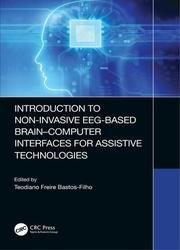 Название: Introduction to Non-Invasive EEG-Based Brain-Computer Interfaces for Assistive Technologies
Название: Introduction to Non-Invasive EEG-Based Brain-Computer Interfaces for Assistive Technologies Автор: Teodiano Freire Bastos-Filho
Издательство: CRC Press
Год: 2021
Страниц: 101
Язык: английский
Формат: pdf (true)
Размер: 10.1 MB
This book aims to bring to the reader an overview about different applications of brain–computer interfaces (BCIs) based on our experience of more than 20 years working on these interfaces. First, in Chapter 1, a review of the human brain and EEG (electroencephalogram) signals is conducted, describing the human brain, anatomically and physiologically, with the objective of showing some of patterns of EEG signals used to control BCIs. The chapter introduces aspects such as planes of section and reference points of the human brain; primary somatosensory cortex (S1), primary motor cortex (M1), primary auditory cortex (A1), primary visual cortex (V1), and the areas of Wernicke and Broca; contralaterality of motor movements (pyramidal tract and contralaterality of motor movements); neuronal circuits and oscillatory activity of the thalamo-cortical system; circuits that are involved in motor activity (direct pathway of movement); EEG; EEG electrodes; EEG acquisition; main EEG rhythms; artifacts present in the EEG signals; methods for EEG filtering, such as spatial filters; signal-to-noise ratio (SNR); event-related potential (ERP); movement-related (cortical) potential (MRP/MRCP); event-related desynchronization/synchronization (ERD/ERS); and steady-state visual evoked potential (SSVEP) and its types: dependent SSVEP and independent SSVEP.
Following, in Chapter 2, the BCI is introduced, and in Chapter 3 different applications of BCIs are discussed, which were developed in our laboratory, such as a BCI based on ERD/ERS patterns in α rhythms, used to command a robotic wheelchair and an augmentative and alternative communication (AAC) system onboard the wheelchair; a BCI based on dependent SSVEP to command the same robotic wheelchair; a BCI based on SSVEP to command a telepresence robot and its onboard AAC system; a BCI based on SSVEP to command an autonomous car; a BCI based on independent SSVEP, using depth-of-field (DoF), to command the same robotic wheelchair of our laboratory; the use of compressive technique in our SSVEP-based BCI; a BCI based on motor imagery (using different techniques) to command a robotic monocycle and a robotic exoskeleton; and our first steps to build a neuro-rehabilitation system based on motor imagery of pedaling together an immersive virtual environment with avatar. This book is concluded with a wide discussion, in Chapter 4, about the future of the non-invasive BCIs.
Скачать Introduction to Non-Invasive EEG-Based Brain-Computer Interfaces for Assistive Technologies